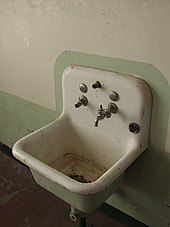spout


A sink is a technical facility that is used to collect and drain liquids. The execution in stoneware or cast stone is also called Spülstein or North German hand stone , in southern Germany and Switzerland Schüttstein .
In general, this is dirty water from the household sector, but also contaminated water from laboratory areas. Sinks can be found in kitchens (commercial kitchens, large kitchens), utility rooms, cleaning rooms and unclean rooms in hospitals. In kitchens the sink was created from this , in the bathroom the wash basin .
Nowadays, spouts usually have a rectangular shape. In the early days of modern installations, there were also semicircular spouts, which were often installed in the stairwell. In Vienna this was called Bassena , with the function of a water point (since there was no water connection in the apartments), which is why the pools were known as a meeting place for residents or their house staff and thus as a place of gossip. Such semicircular spouts in historicizing shapes are offered in hardware stores as spouts for the garden area.
Since heavily contaminated water with sometimes very aggressive ingredients is emptied (poured out) into a sink, it must be made of resistant material. Preferred materials are: cast iron inside enamelled , fireclay , porcelain , stoneware , cast stone , stainless steel and chemically resistant plastics .
There are also spouts with back walls of different heights made of the same materials. They are used when the wall is not protected from dirt by other structural measures, such as B. by tiles . This rear wall can be an integral part of the spout or it can be offered as an additional component. Depending on the height of the rear wall, it is also offered with so-called tap holes for installing the inlet fitting .
Protective edges made of wood or plastic are screwed, glued or just clamped onto the front edge of the sink, especially in the case of spouts made of enamelled gray cast iron or porcelain , in order to prevent scratching by z. B. to prevent metal cleaning bucket.
There is often a hinged grate made of wood, galvanized steel, stainless steel or plastic on the sink . A bucket, watering can or other container can be placed on this grate in order to be filled with water. For this purpose, the outlet fitting is to be placed high enough.
Pool drain
In the past, the drains mostly simply led outside, in the Middle Ages and the early modern period many streets in cities were flooded with wastewater, and neighborhood disputes often arose due to the nuisance of foreign sewage. It was not until the second half of the 19th century, and even later in rural areas, that these unsanitary conditions were eliminated with the introduction of sewer systems.
In the basin drain of a modern sink, there must be a grate, a sieve or cross bars to prevent coarse debris from clogging the sewer system . The passage widths for this are specified in DIN 1986 .
Sinks can be screwed directly to the wall, partly through the attached rear wall, but mostly they are placed on cantilever arms attached to the wall and screwed tight.
Following the process, i. d. Usually there is a siphon . Furthermore, different water purification devices such as grease separators (or possibly plaster separators ) are useful or even prescribed - depending on the intended use (kitchen, doctor's office). The term spout is also used in common parlance for the washstand or the wash basin .

